Municipal courts in the United States
Free Shipping on US orders over $49 USD and 5 lbs or less at eVitamins.com!
Free Shipping on US orders over $49 USD and 5 lbs or less at eVitamins.com!
List of courts of the United States
(Redirected from Courts of the United States)
Jump to navigationJump to search
The courts of the United States are closely linked hierarchical systems of courts at the federal and state levels. The federal courts form the judicial branch of the federal government of the United States and operate under the authority of the United States Constitution and federal law. The state and territorial courts of the individual U.S. states and territories operate under the authority of the state and territorial constitutions and state and territorial law.
Federal statutes that refer to the "courts of the United States" are referring only to the courts of the federal government, and not the courts of the individual states and counties. Because of the federalist underpinnings of the division between sovereign federal and state governments, the various state court systems are free to operate in ways that vary widely from those of the federal government, and from one another. In practice, however, every state has adopted a division of its judiciary into at least two levels, and almost every state has three levels, with trial courts hearing cases which may be reviewed by appellate courts, and finally by a state supreme court. A few states have two separate supreme courts, with one having authority over civil matters and the other reviewing criminal cases. 47 states and the federal government allow at least one appeal of right from a final judgment on the merits, meaning that the court receiving the appeal must decide the appeal after it is briefed and argued properly. Three states do not provide a right to a first appeal. Rather, they give litigants only a right to petition for the right to have an appeal heard.
State courts often have diverse names and structures, as illustrated below. State courts hear about 98% of litigation; most states have courts of special jurisdiction, which typically handle minor disputes such as traffic citations, and courts of general jurisdiction responsible for more serious disputes.[1]
The U.S. federal court system hears cases involving litigants from two or more states, violations of federal laws, treaties, and the Constitution, admiralty, bankruptcy, and related issues.[2] In practice, about 80% of the cases are civil and 20% criminal.[1] The civil cases often involve civil rights, patents, and Social Security while the criminal cases involve tax fraud, robbery, counterfeiting, and drug crimes.[1] The trial courts are U.S. district courts, followed by United States courts of appeals and then the Supreme Court of the United States. The judicial system, whether state or federal, begins with a court of first instance, whose work may be reviewed by an appellate court, and then ends at the court of last resort, which may review the work of the lower courts.[3]
Institutions which may be considered courts of the United States are listed below.
Contents
- 1United States Federal Courts
- 2Courts by state of the United States
- 2.1Alabama
- 2.2Alaska
- 2.3Arizona
- 2.4Arkansas
- 2.5California
- 2.6Colorado
- 2.7Connecticut
- 2.8Delaware
- 2.9Florida
- 2.10Georgia
- 2.11Hawaii
- 2.12Idaho
- 2.13Illinois
- 2.14Indiana
- 2.15Iowa
- 2.16Kansas
- 2.17Kentucky
- 2.18Louisiana
- 2.19Maine
- 2.20Maryland
- 2.21Massachusetts
- 2.22Michigan
- 2.23Minnesota
- 2.24Mississippi
- 2.25Missouri
- 2.26Montana
- 2.27Nebraska
- 2.28Nevada
- 2.29New Hampshire
- 2.30New Jersey
- 2.31New Mexico
- 2.32New York
- 2.33North Carolina
- 2.34North Dakota
- 2.35Ohio
- 2.36Oklahoma
- 2.37Oregon
- 2.38Pennsylvania
- 2.39Rhode Island
- 2.40South Carolina
- 2.41South Dakota
- 2.42Tennessee
- 2.43Texas
- 2.44Utah
- 2.45Vermont
- 2.46Virginia
- 2.47Washington
- 2.48West Virginia
- 2.49Wisconsin
- 2.50Wyoming
- 3Courts in the District of Columbia
- 4Courts of the Territories of the United States
- 5Extraterritorial courts of the United States
- 6U.S. judicial system in popular culture
- 7References
- 8External links
United States Federal Courts[edit]
Main article: United States Federal Courts The geographical boundary of the 12 United States Courts of Appeals
The geographical boundary of the 12 United States Courts of AppealsGeographic based jurisdiction[edit]
- Trial Courts: United States district courts[4] (see federal court sections by state below for specific district courts)
- List of United States district and territorial courts (94 courts, also listed by state below)
- Appellate Courts: United States courts of appeals[5]
- United States Court of Appeals for the First Circuit[6]
- United States Court of Appeals for the Second Circuit[7]
- United States Court of Appeals for the Third Circuit[8]
- United States Court of Appeals for the Fourth Circuit[9]
- United States Court of Appeals for the Fifth Circuit[10]
- United States Court of Appeals for the Sixth Circuit[11]
- United States Court of Appeals for the Seventh Circuit[12]
- United States Court of Appeals for the Eighth Circuit[13]
- United States Court of Appeals for the Ninth Circuit[14]
- United States Court of Appeals for the Tenth Circuit[15]
- United States Court of Appeals for the Eleventh Circuit[16]
- United States Court of Appeals for the District of Columbia Circuit[17]
- Court of last resort:
Specific subject-matter jurisdiction[edit]
 Headquarters of the U.S. Court of Federal Claims on Madison Place in Washington, D.C.See also: Article I and Article III tribunals
Headquarters of the U.S. Court of Federal Claims on Madison Place in Washington, D.C.See also: Article I and Article III tribunals- United States federal courts with Original Jurisdiction over specific subject matter:
- United States Tax Court[19]
- Patent Trial and Appeal Board
- International Trade Commission
- United States Court of International Trade[20]
- United States Court of Federal Claims[21]
- United States Foreign Intelligence Surveillance Court[22]
- United States bankruptcy courts[23]
- Trademark Trial and Appeal Board
- United States Merit Systems Protection Board
- United States Alien Terrorist Removal Court
- Courts with Appellate Jurisdiction over specific subject matter:
- United States Court of Appeals for the Federal Circuit[24]
- United States Court of Appeals for the Armed Forces[25]
- United States Court of Appeals for Veterans Claims[26]
- United States Foreign Intelligence Surveillance Court of Review
- United States Court of Military Commission Review
- Civilian Board of Contract Appeals
- Armed Services Board of Contract Appeals
- Postal Service Board of Contract Appeals
- Office of Dispute Resolution for Acquisition
- Board of Immigration Appeals
- Board of Veterans' Appeals
Former United States Courts[edit]
- Board of Patent Appeals and Interferences (before 2012)
- Court of Appeals in Cases of Capture (1780–1789)
- Temporary Emergency Court of Appeals (1971–1992)[27]
- United States circuit courts (1789–1911)
- United States Commerce Court (1910–1913)[28]
- United States Court of Customs and Patent Appeals (1909–1982)
- United States Court of Private Land Claims (1891–1904)[29]
- United States Court for Berlin (1955–1990)
- United States District Court for the Canal Zone ( -1982)
- United States Court for China (1906–1943)
Courts by state of the United States[edit]
Alabama[edit]
Main article: Courts of Alabama- State courts of Alabama
- Supreme Court of Alabama[30]
- Alabama Court of Civil Appeals[31]
- Alabama Court of Criminal Appeals[32]
- Alabama Circuit Courts (41 circuits)[33]
- Alabama District Courts (67 districts)[33]
- Alabama Municipal Courts (273 courts)[33]
- Alabama Probate Courts (68 courts)[33]
- Alabama Circuit Courts (41 circuits)[33]
- Alabama Court of the Judiciary[34]
Federal courts located in Alabama
- United States District Court for the Northern District of Alabama[35]
- United States District Court for the Middle District of Alabama[36]
- United States District Court for the Southern District of Alabama[37]
(All United States District Courts in Alabama may be appealed to the United States Court of Appeals for the Eleventh Circuit, headquartered in Atlanta, Georgia)
Former federal courts of Alabama
- United States District Court for the District of Alabama (extinct, subdivided in 1824)
Alaska[edit]
Main article: Courts of Alaska- Alaska Supreme Court[38]
- Alaska Court of Appeals[38]
- Alaska Superior Court (4 districts containing 40 judgeships)[39]
- Alaska District Court (21 judgeships)[39]
- Alaska Superior Court (4 districts containing 40 judgeships)[39]
- Alaska Court of Appeals[38]
Federal courts located in Alaska
Arizona[edit]
Main article: Courts of Arizona- State courts of Arizona
- Arizona Supreme Court[41]
- Arizona Court of Appeals (2 divisions)[42]
- Superior Court of Arizona (15 counties)[42]
- Justices of the Peace (county courts) [43] and Arizona Municipal Courts, city trial courts and courts of limited jurisdiction
- Superior Court of Arizona (15 counties)[42]
- Arizona Court of Appeals (2 divisions)[42]
Federal courts located in Arizona
Arkansas[edit]
Main article: Courts of Arkansas- State courts of Arkansas
- Arkansas Supreme Court[45]
- Arkansas Court of Appeals[46]
- Arkansas Circuit Courts (23 judicial circuits)[47]
- Arkansas District Courts (formerly Arkansas Municipal Courts) [48]
- Arkansas City Courts[49]
- Arkansas Circuit Courts (23 judicial circuits)[47]
- Arkansas Court of Appeals[46]
Federal courts located in Arkansas
- United States District Court for the Eastern District of Arkansas[50]
- United States District Court for the Western District of Arkansas[51]
- United States Bankruptcy Court for the Eastern and Western Districts of Arkansas
Former federal courts of Arkansas
- United States District Court for the District of Arkansas (extinct, subdivided)
California[edit]
Main article: Courts of California Headquarters of the Supreme Court of California, in San Francisco.
Headquarters of the Supreme Court of California, in San Francisco.- State courts of California
- Supreme Court of California[52]
- California Courts of Appeal (6 appellate districts)[53]
- Superior Courts of California (58 courts, one for each county)[54]
- California Courts of Appeal (6 appellate districts)[53]
Federal courts located in California
- United States Court of Appeals for the Ninth Circuit (headquartered in San Francisco, having jurisdiction over the United States District Courts of Alaska, Arizona, California, Guam, Hawaii, Idaho, Montana, Nevada, the Northern Mariana Islands, Oregon, and Washington)
Former federal courts of California
- United States District Court for the District of California (extinct, subdivided)
Colorado[edit]
Main article: Courts of Colorado- State courts of Colorado
- Colorado Supreme Court[59]
- Colorado Court of Appeals[60]
- Colorado District Courts (22 judicial districts)[61]
- Colorado Court of Appeals[60]
Federal courts located in Colorado
- United States Court of Appeals for the Tenth Circuit (headquartered in Denver, having jurisdiction over the United States District Courts of Colorado, Kansas, New Mexico, Oklahoma, Utah, and Wyoming)
- United States District Court for the District of Colorado[63]
Connecticut[edit]
Main article: Courts of Connecticut- State courts of Connecticut
- Connecticut Supreme Court[64]
- Connecticut Appellate Court[65]
- Connecticut Superior Court (13 districts)[66]
- Connecticut Probate Courts (54 districts)[67]
- Connecticut Appellate Court[65]
Federal court located in Connecticut:
Delaware[edit]
Main article: Courts of Delaware- State courts of Delaware
Federal courts located in Delaware
Florida[edit]
Main article: Courts of Florida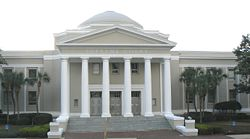 Headquarters of the Florida Supreme Court in Tallahassee.
Headquarters of the Florida Supreme Court in Tallahassee.- State courts of Florida
- Florida Supreme Court[75]
- Florida District Courts of Appeal (5 districts)[76]
- Florida Circuit Courts (20 judicial circuits)[77]
- Florida County Courts (67 courts, one for each county)[78]
- Florida Circuit Courts (20 judicial circuits)[77]
- Florida District Courts of Appeal (5 districts)[76]
Federal courts located in Florida
- United States District Court for the Northern District of Florida[79]
- United States District Court for the Middle District of Florida[80]
- United States District Court for the Southern District of Florida[81]
Former federal courts of Florida
- United States District Court for the District of Florida (extinct, subdivided)
Georgia[edit]
Main article: Courts of Georgia (U.S. state)- State courts of Georgia
Federal courts located in Georgia
- United States Court of Appeals for the Eleventh Circuit (headquartered in Atlanta, having jurisdiction over the United States District Courts of Alabama, Florida, and Georgia)
- United States District Court for the Northern District of Georgia[90]
- United States District Court for the Middle District of Georgia[91]
- United States District Court for the Southern District of Georgia[92]
Former federal courts of Georgia
- United States District Court for the District of Georgia (extinct, subdivided)
Hawaii[edit]
Main article: Courts of Hawaii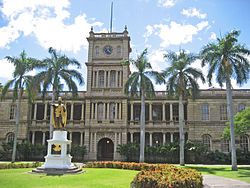 Aliʻiōlani Hale, in Honolulu, the building where the Hawaiʻi State Supreme Court meets
Aliʻiōlani Hale, in Honolulu, the building where the Hawaiʻi State Supreme Court meets- State courts of Hawaii
- Hawaiʻi State Supreme Court[93]
- Hawaii Intermediate Court of Appeals[94]
- Hawaii State circuit courts (4 circuits)[95]
- Hawaii State family courts (4 circuits)[96]
- Hawaii State district courts (including Small Claims Court)[97]
- Hawaiʻi State Land Court[98]
- Hawaii Tax Appeal Court[98]
- Hawaii Intermediate Court of Appeals[94]
Federal courts located in Hawaii
Idaho[edit]
Main article: Courts of Idaho- State courts of Idaho
Federal courts located in Idaho
Illinois[edit]
Main article: Courts of Illinois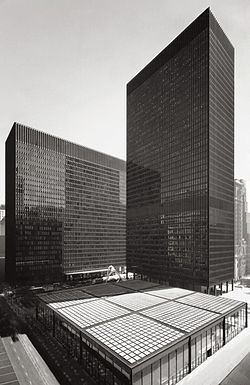 The Dirksen Federal Building in Chicago, headquarters of the United States Court of Appeals for the Seventh Circuit.
The Dirksen Federal Building in Chicago, headquarters of the United States Court of Appeals for the Seventh Circuit.State courts of Illinois
Further information: State court (United States)- Supreme Court of Illinois[103]
- Illinois Appellate Court (5 districts)[104]
- Illinois Circuit Courts (24 judicial circuits)[105]
- Illinois Appellate Court (5 districts)[104]
Federal courts located in Illinois
Further information: Federal judiciary of the United States- United States Court of Appeals for the Seventh Circuit (headquartered in Chicago, having jurisdiction over the United States District Courts of Illinois, Indiana, and Wisconsin)
- United States District Court for the Northern District of Illinois[106]
- United States District Court for the Central District of Illinois[107]
- United States District Court for the Southern District of Illinois[108]
Former federal courts of Illinois
- United States District Court for the District of Illinois (extinct, subdivided in 1855)[109]
- United States District Court for the Eastern District of Illinois (extinct, reorganized in 1978)[109]
Indiana[edit]
Main article: Courts of Indiana- State courts of Indiana
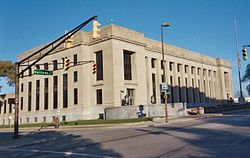 The E. Ross Adair Federal Building, seat of the Fort Wayne division of the U.S. District Court for the Northern District of Indiana
The E. Ross Adair Federal Building, seat of the Fort Wayne division of the U.S. District Court for the Northern District of Indiana- Indiana Supreme Court[110]
- Indiana Court of Appeals (5 districts; previously Indiana Appellate Court)[111]
Federal courts located in Indiana
- United States District Court for the Northern District of Indiana[115]
- United States District Court for the Southern District of Indiana[116]
Former federal courts of Indiana
- United States District Court for the District of Indiana (extinct, subdivided)
Iowa[edit]
Main article: Courts of Iowa- State courts of Iowa
Federal courts located in Iowa
- United States District Court for the Northern District of Iowa[120]
- United States District Court for the Southern District of Iowa[121]
Former federal courts of Iowa
- United States District Court for the District of Iowa (extinct, subdivided)
Kansas[edit]
Main article: Courts of Kansas- State courts of Kansas
Federal courts located in Kansas
Kentucky[edit]
Main article: Courts of Kentucky- Kentucky Court of Justice
Under an amendment to the Kentucky Constitution passed by the state's voters in 1975,[127] judicial power in Kentucky is "vested exclusively in one Court of Justice", divided into the following:[128]
- Kentucky Supreme Court[129]
- Kentucky Court of Appeals[130]
- Kentucky Circuit Courts (57 circuits)[131]
- Kentucky District Courts (60 judicial districts)[132]
- Kentucky Circuit Courts (57 circuits)[131]
- Kentucky Court of Appeals[130]
- Federal courts located in this state
- United States District Court for the Eastern District of Kentucky[133]
- United States District Court for the Western District of Kentucky[134]
- Former federal courts of Kentucky
- United States District Court for the District of Kentucky (extinct, subdivided)
Louisiana[edit]
Main article: Courts of Louisiana- State courts of Louisiana
 Louisiana judicial districts map
Louisiana judicial districts map- Louisiana Supreme Court[135]
- Louisiana Circuit Courts of Appeal (5 circuits)[136]
- Louisiana District Courts (42 districts)[137]
- Louisiana Circuit Courts of Appeal (5 circuits)[136]
- Federal courts located in Louisiana
 The John Minor Wisdom U.S. Courthouse, home of the United States Court of Appeals for the Fifth Circuit in New Orleans
The John Minor Wisdom U.S. Courthouse, home of the United States Court of Appeals for the Fifth Circuit in New Orleans- United States Court of Appeals for the Fifth Circuit (headquartered in New Orleans, Louisiana; having jurisdiction over the United States District Courts of Louisiana, Mississippi, and Texas)
- United States District Court for the Eastern District of Louisiana[138]
- United States District Court for the Middle District of Louisiana[139]
- United States District Court for the Western District of Louisiana[140]
- Former federal courts of Louisiana
- United States District Court for the District of Orleans (territorial court of the Territory of Orleans, extinct, abolished when Louisiana became a state on April 30, 1812)
- United States District Court for the District of Louisiana (extinct, subdivided)
Maine[edit]
Main article: Courts of Maine- State courts of Maine
Federal courts located in Maine
Maryland[edit]
Main article: Courts of Maryland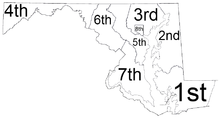 Maryland judicial circuit map
Maryland judicial circuit map- State courts of Maryland
- Maryland Court of Appeals[146]
- Maryland Court of Special Appeals[147]
- Maryland Circuit Courts (8 judicial circuits)[148]
- Maryland District Courts (34 locations in 12 judicial districts)[149]
- Maryland Circuit Courts (8 judicial circuits)[148]
- Maryland Court of Special Appeals[147]
Federal courts located in Maryland
Former federal courts of Maryland
- United States District Court for the District of Potomac (1801–1802; also contained the District of Columbia and pieces of Virginia; extinct, reorganized)[151]
Massachusetts[edit]
Main article: Courts of Massachusetts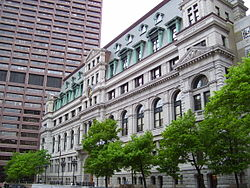 John Adams Courthouse in Boston, Massachusetts, home to the Massachusetts Supreme Judicial Court and Massachusetts Appeals Court
John Adams Courthouse in Boston, Massachusetts, home to the Massachusetts Supreme Judicial Court and Massachusetts Appeals Court- State courts of Massachusetts
- Judicial courts
- Administrative courts
Federal courts located in Massachusetts
- United States Court of Appeals for the First Circuit (headquartered in Boston, having jurisdiction over the United States District Courts of Maine, Massachusetts, New Hampshire, Rhode Island, and Puerto Rico)
- United States District Court for the District of Massachusetts[164]
Michigan[edit]
Main article: Courts of Michigan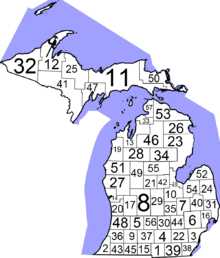 Judicial circuits map
Judicial circuits map- State courts of Michigan
Federal courts located in Michigan
- United States District Court for the Eastern District of Michigan[168]
- United States District Court for the Western District of Michigan[169]
Former federal courts of Michigan
- United States District Court for the District of Michigan (extinct, subdivided on February 24, 1863)
Minnesota[edit]
Main article: Courts of Minnesota Supreme Court Chamber of the Minnesota Supreme Court in the Minnesota State Capitol in Saint Paul.
Supreme Court Chamber of the Minnesota Supreme Court in the Minnesota State Capitol in Saint Paul.- State courts of Minnesota
Federal courts located in Minnesota
Mississippi[edit]
Main article: Courts of Mississippi- State courts of Mississippi
Federal courts located in Mississippi
- United States District Court for the Northern District of Mississippi[185]
- United States District Court for the Southern District of Mississippi[186]
Former federal courts of Mississippi
- United States District Court for the District of Mississippi (extinct, subdivided on June 18, 1838)
Missouri[edit]
Main article: Courts of Missouri- State courts of Missouri
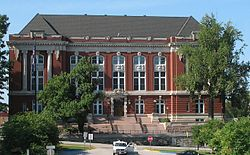 Missouri State Supreme Court building across from state capitol in Jefferson City.
Missouri State Supreme Court building across from state capitol in Jefferson City.Federal courts located in Missouri
- United States Court of Appeals for the Eighth Circuit (headquartered in St. Louis, having jurisdiction over the United States District Courts of Arkansas, Iowa, Minnesota, Missouri, Nebraska, North Dakota, South Dakota)
- United States District Court for the Eastern District of Missouri[191]
- United States District Court for the Western District of Missouri[192]
Former federal courts of Missouri
- United States District Court for the District of Missouri (extinct, subdivided)
Montana[edit]
Main article: Courts of Montana- State courts of Montana
- Montana Supreme Court[193]
- Montana District Courts (56 courts, 22 judicial districts)[194][195]
- Montana Youth Courts, Generally assigned to District Court Judges, cases appealed to the Montana Supreme Court.[197]
- Montana Worker's Compensation Court[195]
- Montana Water Court[195]
- Montana Asbestos Claims Court[198]
Federal courts located in Montana
- United States District Court for the District of Montana[199]
- United States Bankruptcy Court for the District of Montana[200]
Nebraska[edit]
Main article: Courts of Nebraska- State courts of Nebraska
Federal courts located in Nebraska
Nevada[edit]
Main article: Judiciary of Nevada- State courts of Nevada
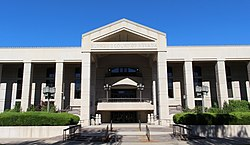 The headquarters of the Supreme Court of Nevada in Carson City.
The headquarters of the Supreme Court of Nevada in Carson City.Federal courts located in Nevada
New Hampshire[edit]
Main article: Courts of New Hampshire- State courts of New Hampshire
Federal courts located in New Hampshire
New Jersey[edit]
Main article: Courts of New Jersey- State courts of New Jersey
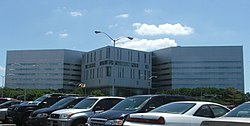 Richard J. Hughes Justice Complex, Trenton, New Jersey: The seat of the New Jersey Supreme Court and the central administrative offices of all statewide courts in New Jersey.
Richard J. Hughes Justice Complex, Trenton, New Jersey: The seat of the New Jersey Supreme Court and the central administrative offices of all statewide courts in New Jersey.- New Jersey Supreme Court (previously the New Jersey Court of Errors and Appeals)[222]
Federal courts located in New Jersey
Former federal courts of New Jersey
- United States District Court for the District of East Jersey (1801–1802; extinct, merged)
- United States District Court for the District of West Jersey (1801–1802; extinct, merged)
New Mexico[edit]
Main article: Courts of New Mexico- State courts of New Mexico
Federal courts located in New Mexico
New York[edit]
Main article: Courts of New York- State courts of New York
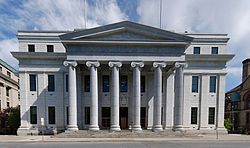 The 1842 courthouse of the New York Court of Appeals in Albany
The 1842 courthouse of the New York Court of Appeals in Albany- New York Court of Appeals[232]
- New York Supreme Court, Appellate Division (4 departments)[233]
- New York Supreme Court (13 judicial districts)[234]
- New York County Court (57 courts, one for each county outside New York City)[235]
- New York Surrogate's Court
- New York Family Court
- New York Court of Claims[236]
- New York City courts
- New York District Court
- New York town and village courts[237]
- New York Supreme Court, Appellate Division (4 departments)[233]
Federal courts located in New York
- United States Court of Appeals for the Second Circuit (headquartered in Manhattan, having jurisdiction over the United States District Courts of Connecticut, New York, and Vermont)
- United States Court of International Trade (headquartered in New York City)
Former federal courts of New York
- United States District Court for the District of New York (extinct, subdivided)
North Carolina[edit]
Main article: Courts of North Carolina- State courts of North Carolina
- North Carolina Supreme Court[242]
- North Carolina Court of Appeals[243]
- North Carolina Superior Court (46 districts)[244]
- North Carolina District Courts (45 districts)[245]
- North Carolina Court of Appeals[243]
Federal courts located in North Carolina
- United States District Court for the Eastern District of North Carolina[246]
- United States District Court for the Middle District of North Carolina[247]
- United States District Court for the Western District of North Carolina[248]
Former federal courts of North Carolina
- United States District Court for the District of North Carolina (extinct, subdivided)
- United States District Court for the District of Edenton (1794–1797; extinct, reorganized)
- United States District Court for the District of New Bern (1794–1797; extinct, reorganized)
- United States District Court for the District of Wilmington (1794–1797; extinct, reorganized)
- United States District Court for the District of Albemarle (1801–1872; extinct, reorganized)
- United States District Court for the District of Cape Fear (1801–1872; extinct, reorganized)
- United States District Court for the District of Pamptico (1801–1872; extinct, reorganized)
North Dakota[edit]
Main article: Courts of North Dakota- State courts of North Dakota
- North Dakota Supreme Court[249]
- North Dakota District Courts (7 judicial districts)[250]
Federal courts located in North Dakota
Ohio[edit]
Main article: Courts of Ohio- State courts of Ohio
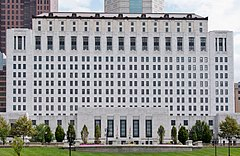 The Thomas J. Moyer Ohio Judicial Center in Columbus, headquarters of the Supreme Court of Ohio
The Thomas J. Moyer Ohio Judicial Center in Columbus, headquarters of the Supreme Court of OhioFederal courts located in this state
- United States Court of Appeals for the Sixth Circuit (headquartered in Cincinnati, having jurisdiction over the United States District Courts of Kentucky, Michigan, Ohio, and Tennessee)
- United States District Court for the Northern District of Ohio[257]
- United States District Court for the Southern District of Ohio[258]
Former federal courts of Ohio
- United States District Court for the District of Ohio (extinct, subdivided)
Oklahoma[edit]
Main article: Courts of Oklahoma- State courts of Oklahoma
- Oklahoma Supreme Court (civil)[259]
- Oklahoma Court of Criminal Appeals (criminal)[260]
- Oklahoma Court of Civil Appeals[259]
- Oklahoma District Courts (26 judicial districts with 77 district courts)[259]
- Oklahoma Workers' Compensation Court[261]
- Oklahoma Court of Civil Appeals[259]
Federal courts located in Oklahoma
- United States District Court for the Eastern District of Oklahoma[262]
- United States District Court for the Northern District of Oklahoma[263]
- United States District Court for the Western District of Oklahoma[264]
Oregon[edit]
Main article: Courts of Oregon- State courts of Oregon
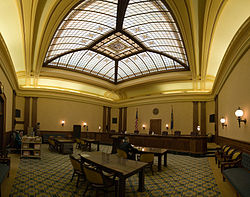 Courtroom of the Oregon Supreme Court.
Courtroom of the Oregon Supreme Court.- Oregon Supreme Court[265]
- Oregon Court of Appeals[266]
- Oregon Circuit Courts (36 courts, one for each county, administratively divided between 27 judicial districts)[267]
- Oregon Justice Courts[268]
- Oregon Municipal Courts[269]
- Oregon County Courts[268]
- Oregon Tax Court[270]
- Oregon Court of Appeals[266]
Federal courts located in Oregon
Pennsylvania[edit]
Main article: Courts of Pennsylvania- State courts of Pennsylvania
- Supreme Court of Pennsylvania[272]
- Superior Court of Pennsylvania (3 districts)[273]
- Commonwealth Court of Pennsylvania[274]
- Pennsylvania Courts of Common Pleas (60 judicial districts)[275]
Federal courts located in Pennsylvania
- United States Court of Appeals for the Third Circuit (headquartered in Philadelphia, having jurisdiction over the United States District Courts of Delaware, New Jersey, Pennsylvania, and the United States Virgin Islands)
Former federal courts of Pennsylvania
- United States District Court for the District of Pennsylvania (extinct, subdivided in 1815)
Rhode Island[edit]
Main article: Courts of Rhode Island- State courts of Rhode Island
Federal courts located in Rhode Island
South Carolina[edit]
Main article: Courts of South Carolina- State courts of South Carolina
Federal courts located in South Carolina
South Dakota[edit]
Main article: Courts of South DakotaState courts of South Dakota
Federal courts located in South Dakota
Tennessee[edit]
Main article: Courts of Tennessee- State courts of Tennessee
- Tennessee Supreme Court[299]
- Tennessee Court of Appeals (3 grand divisions)[300]
- Tennessee Court of Criminal Appeals (3 grand divisions)[301]
- Tennessee Circuit Courts (31 judicial districts)[302]
- Tennessee Chancery and Probate Courts (31 judicial districts)[302]
- Tennessee Criminal Courts (31 judicial districts)[302]
- Tennessee Municipal and City Courts[302]
- Tennessee Juvenile and Family Courts[303]
- Tennessee General Session Courts[304]
Federal courts located in Tennessee
- United States District Court for the Eastern District of Tennessee[305]
- United States District Court for the Middle District of Tennessee[306]
- United States District Court for the Western District of Tennessee[307]
Former federal courts of Tennessee
- United States District Court for the District of Tennessee (extinct, subdivided)
Texas[edit]
Main article: Courts of Texas- State courts of Texas
- Texas Supreme Court (Civil)[308]
- Texas Court of Criminal Appeals (Criminal)[309]
Federal courts located in Texas
- United States District Court for the Eastern District of Texas[315]
- United States District Court for the Northern District of Texas[316]
- United States District Court for the Southern District of Texas[317]
- United States District Court for the Western District of Texas[318]
Former federal courts of Texas
- United States District Court for the District of Texas (extinct, subdivided)
Utah[edit]
Main article: Courts of Utah The Utah Supreme Court meets in the Scott M. Matheson Courthouse.
The Utah Supreme Court meets in the Scott M. Matheson Courthouse.- State courts of Utah
Federal courts located in Utah
Vermont[edit]
Main article: Courts of Vermont- State courts of Vermont
Federal courts located in Vermont
Virginia[edit]
Main article: Courts of Virginia- State courts of Virginia
- Supreme Court of Virginia[334]
- Court of Appeals of Virginia[335]
- Virginia Circuit Court (120 courts divided among 31 judicial circuits)[336]
- Virginia General District Court (courts in 32 districts)[337]
- Virginia Juvenile and Domestic Relations District Court (courts in 32 districts)[338]
- Virginia Circuit Court (120 courts divided among 31 judicial circuits)[336]
- Court of Appeals of Virginia[335]
Federal courts located in Virginia
- United States Court of Appeals for the Fourth Circuit (headquartered in Richmond, having jurisdiction over the United States District Courts of Maryland, North Carolina, South Carolina, Virginia, and West Virginia)
- United States District Court for the Eastern District of Virginia[339]
- United States District Court for the Western District of Virginia[340]
Former federal courts of Virginia
- United States District Court for the District of Virginia (extinct, subdivided)
- United States District Court for the District of Potomac (1801-1802; also contained the District of Columbia and pieces of Maryland; extinct, reorganized)[341]
Washington[edit]
Main article: Courts of Washington (state)State courts of Washington
 The headquarters of the Washington Supreme Court in Olympia.
The headquarters of the Washington Supreme Court in Olympia.- Washington Supreme Court[342]
- Washington Court of Appeals (3 divisions)[343]
- Washington Superior Courts (39 courts of general jurisdiction, one for each county)[344]
- Washington District Courts (Courts of limited jurisdiction)[345]
- Washington Municipal Courts (Courts of limited jurisdiction)[346]
- Washington Superior Courts (39 courts of general jurisdiction, one for each county)[344]
- Washington Court of Appeals (3 divisions)[343]
Federal courts located in Washington
- United States District Court for the Eastern District of Washington[347]
- United States District Court for the Western District of Washington[348]
Former federal courts of Washington
- United States District Court for the District of Washington (extinct, subdivided)
West Virginia[edit]
Main article: Courts of West Virginia- State courts of West Virginia
Federal courts located in West Virginia
- United States District Court for the Northern District of West Virginia[350]
- United States District Court for the Southern District of West Virginia[351]
Former federal courts of West Virginia
- United States District Court for the District of West Virginia (extinct, subdivided)
Wisconsin[edit]
Main article: Courts of Wisconsin- State courts of Wisconsin
- Wisconsin Supreme Court[352]
- Wisconsin Court of Appeals (4 districts)[353]
- Wisconsin Circuit Court (10 judicial administrative districts)[354]
- Wisconsin Court of Appeals (4 districts)[353]
Federal courts located in Wisconsin
- United States District Court for the Eastern District of Wisconsin[356]
- United States District Court for the Western District of Wisconsin[357]
Former federal courts of Wisconsin
- United States District Court for the District of Wisconsin (extinct, subdivided)
Wyoming[edit]
Main article: Courts of Wyoming- State courts of Wyoming
Federal courts located in Wyoming
Courts in the District of Columbia[edit]
Federal courts located in the District of Columbia
- Supreme Court of the United States
Former federal courts in the District of Columbia
- United States District Court for the District of Potomac (1801–1802; also contained pieces of Maryland and Virginia; extinct, reorganized)[151]
Courts of the Territories of the United States[edit]
See also: United States territorial courtAmerican Samoa[edit]
 High Court of American Samoa courthouse
High Court of American Samoa courthouseGuam[edit]
United States territorial court[edit]
Northern Mariana Islands[edit]
United States territorial court[edit]
Panama Canal Zone[edit]
- United States District Court for the Canal Zone[372] (abolished 1982)
Puerto Rico[edit]
- Supreme Court of Puerto Rico (Tribunal Supremo de Puerto Rico)[373]
- Circuit Court of Appeals of Puerto Rico (Tribunal de Apelaciones)[374]
- * Courts of First Instance of Puerto Rico (Tribunal de Primera Instancia; 13 divisions)[375]
Federal courts located in Puerto Rico:
United States Virgin Islands[edit]
- United States Virgin Islands Supreme Court[377]
- United States Virgin Islands Superior Court (2 divisions)[378]
United States territorial court[edit]
Extraterritorial courts of the United States[edit]
- United States Court for China (1906 to 1943), appointed judge held court in cities in China including Shanghai, Hankow, Tientsin, and Canton.[380][381]
- United States Court for Berlin (1979), existed on paper since 1955, but constituted in fact only once, to hear a single case.
U.S. judicial system in popular culture[edit]
Due to its involvement in the resolution of crimes and conflicts, which are an intricate part of drama, the U.S. judicial system is often portrayed in American literature and films.
Several Hollywood films such as A Few Good Men (1992) and Runaway Jury (2003) are set around its courts.




